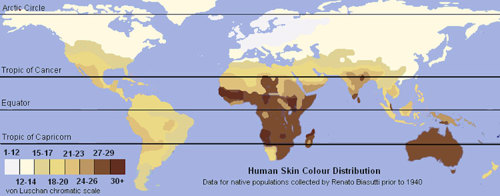
Where do different skin colors come from?
November 6, 2008

- Related Topics:
- Skin pigmentation,
- Pigmentation traits,
- Human evolution,
- Complex traits,
- Freckles
A curious adult from California asks:
Human skin color can vary from almost translucent to almost black. This range of colors comes from the amount and type of a pigment called melanin found in the skin.
There are two types of melanin – eumelanin and pheomelanin. In general, the more eumelanin in your skin, the darker your skin will be. People who make more pheomelanin than eumelanin tend to have lighter skin with freckles.
Like many other traits, the amount and kind of pigment in your skin is controlled by your genes. The version you have of each of these genes work together to create the final product – your skin color.
To understand how this works, we’ll talk about some of the genes that scientists have found that affect human coloring. And how some fish helped us find these genes!
It is also interesting to think about why we have different skin colors. Later on, we’ll see how vitamins and where your ancestors lived might have influenced what your skin color is.
Melanin and Your Skin
Melanin is made in special cells called melanocytes. These cells are found in the epidermis of your skin.
There are at least three ways people can end up with different skin colors. One way is if people make less pigment. Less pigment = lighter skin.
Another way is when people have fewer melanocytes. Fewer melanocytes mean less pigment overall and so lighter skin.
The third way is a bit more complicated and has to do with the kind of pigment someone makes. There are two types of melanin. Eumelanin is black or brown pigment and pheomelanin is red or yellow pigment.
People who make lots of pheomelanin tend to have lighter skin, often because of freckling. Freckles happen when melanocytes clump together.
Melanocytes are usually spread pretty evenly in the skin. So when freckles form, some spots of the skin have lots of melanocytes (freckles) and other spots have few or none. Where there are no melanocytes, the skin is very fair.

Skin Color Genes
Scientists have figured out that several genes are involved in skin color. One of these genes is the melanocortin 1 receptor (MC1R).
When MC1R is working well, it helps melanocytes convert pheomelanin into eumelanin. If it’s not working well, then pheomelanin builds up.
Most people with red hair and/or very fair skin have versions of the MC1R gene that don't work well.1 This means they end up with lots of pheomelanin, which leads to lighter skin.
Two other skin color genes were first identified in fish. One gene was found in stickleback fish and the other in zebrafish.
Researchers studying the stickleback fish found that the kit ligand gene (KITLG) was different between dark and light stickleback fish.2 They also found that humans have different versions of this gene too! And that certain versions lead to lighter skin.
The kit ligand gene is needed for the survival of melanocytes. So if a person (or a fish) has a version of this gene that doesn’t work well, their melanocytes won’t survive as well. Fewer melanocytes will mean less pigment. And so lighter skin.
Researchers studying zebrafish with light colored stripes found another gene involved in human skin color, SLC24A5 (also called the “golden” gene).4 The fish with light colored stripes had a version of this gene that didn't work well. When they looked in people, researchers found that some lighter skinned people also had a poorly working version of this gene.
Unlike the case with KITLG, scientists don’t know for sure what SLC24A5 does. Some clues suggest that it may be important for moving calcium into cells. It may be that calcium is important for having more melanin in cells.
Scientists have figured out that lighter skinned East Asian people get their skin color mostly from a non-working version of KITLG. Northern European people with lighter skin often have a poorly working version of SLC24A5. A small number of pale northern Europeans get their skin color from a non-working MC1R gene.
Although these three genes help to account for skin color differences between populations, there are probably other genes that scientists have yet to find. And scientists are hard at work to find the genes that make different people within a population have different colored skin. Think northern and southern Europeans. Or eastern and southern Asians.

Why different skin colors may have evolved
It is pretty obvious that people whose ancestors come from Northern Europe or Japan tend to have lighter skin than people whose ancestors are from sub-Saharan Africa or Australia. The reason for these differences may have to do with the amount of sunlight in each place.
Sunlight can be pretty dangerous stuff because of its ultraviolet (UV) light. UV light can do things like destroy folic acid or cause changes (mutations) in the DNA of some skin cells. Sometimes, these mutations can lead to skin cancer.
Darker skin is helpful when there is a lot of sunlight because it protects the skin from UV light. But sunlight isn’t all bad. Sunlight can help our bodies make vitamin D.
Everyone needs vitamin D and you have probably seen it in things like your milk. When we don't have enough vitamin D, it can cause problems with your bones. Vitamin D deficiency can cause things like rickets or osteoporosis. It has even been linked to some types of cancer.
When our skin gets UV rays from the sun, our bodies use the UV light to make vitamin D. But melanin in our skin acts like a filter, making it harder for people with more melanin (darker skin) to make vitamin D. This means that the more melanin you have, the more sunshine you need to make enough vitamin D.
Imagine you lived somewhere cold and dark. Your skin wouldn’t see much sunshine. How would your body get enough sunshine to make all of the vitamin D you needed? Well, if your skin had less melanin (which would make it lighter colored), then you would need less time in the sun to make enough vitamin D!

So it's possible that lighter skin evolved so that people in darker places were able to get all of the vitamin D they needed to stay healthy (and have kids). So the skin color you have might be a result of how much sun your ancestors got!
Now we know that skin color is just a matter of how much melanin you have. The versions of the skin color genes tell your body how much melanin to make. All of this means that the difference between dark and light skin is only a few changes in DNA!

 Skip Navigation
Skip Navigation
